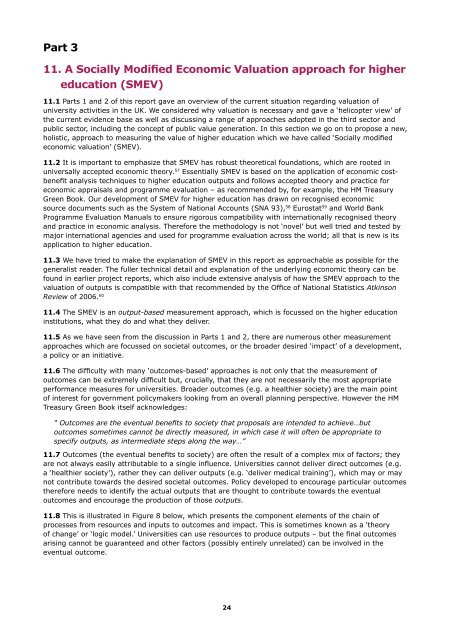Through a glass darkly Measuring the social value of universities
80096 NCCPE Social Value Report (2)
80096 NCCPE Social Value Report (2)
- No tags were found...
Create successful ePaper yourself
Turn your PDF publications into a flip-book with our unique Google optimized e-Paper software.
Part 311. A Socially Modified Economic Valuation approach for highereducation (SMEV)11.1 Parts 1 and 2 <strong>of</strong> this report gave an overview <strong>of</strong> <strong>the</strong> current situation regarding valuation <strong>of</strong>university activities in <strong>the</strong> UK. We considered why valuation is necessary and gave a ‘helicopter view’ <strong>of</strong><strong>the</strong> current evidence base as well as discussing a range <strong>of</strong> approaches adopted in <strong>the</strong> third sector andpublic sector, including <strong>the</strong> concept <strong>of</strong> public <strong>value</strong> generation. In this section we go on to propose a new,holistic, approach to measuring <strong>the</strong> <strong>value</strong> <strong>of</strong> higher education which we have called ‘Socially modifiedeconomic valuation’ (SMEV).11.2 It is important to emphasize that SMEV has robust <strong>the</strong>oretical foundations, which are rooted inuniversally accepted economic <strong>the</strong>ory. 57 Essentially SMEV is based on <strong>the</strong> application <strong>of</strong> economic costbenefitanalysis techniques to higher education outputs and follows accepted <strong>the</strong>ory and practice foreconomic appraisals and programme evaluation – as recommended by, for example, <strong>the</strong> HM TreasuryGreen Book. Our development <strong>of</strong> SMEV for higher education has drawn on recognised economicsource documents such as <strong>the</strong> System <strong>of</strong> National Accounts (SNA 93), 58 Eurostat 59 and World BankProgramme Evaluation Manuals to ensure rigorous compatibility with internationally recognised <strong>the</strong>oryand practice in economic analysis. Therefore <strong>the</strong> methodology is not ‘novel’ but well tried and tested bymajor international agencies and used for programme evaluation across <strong>the</strong> world; all that is new is itsapplication to higher education.11.3 We have tried to make <strong>the</strong> explanation <strong>of</strong> SMEV in this report as approachable as possible for <strong>the</strong>generalist reader. The fuller technical detail and explanation <strong>of</strong> <strong>the</strong> underlying economic <strong>the</strong>ory can befound in earlier project reports, which also include extensive analysis <strong>of</strong> how <strong>the</strong> SMEV approach to <strong>the</strong>valuation <strong>of</strong> outputs is compatible with that recommended by <strong>the</strong> Office <strong>of</strong> National Statistics AtkinsonReview <strong>of</strong> 2006. 6011.4 The SMEV is an output-based measurement approach, which is focussed on <strong>the</strong> higher educationinstitutions, what <strong>the</strong>y do and what <strong>the</strong>y deliver.11.5 As we have seen from <strong>the</strong> discussion in Parts 1 and 2, <strong>the</strong>re are numerous o<strong>the</strong>r measurementapproaches which are focussed on societal outcomes, or <strong>the</strong> broader desired ‘impact’ <strong>of</strong> a development,a policy or an initiative.11.6 The difficulty with many ‘outcomes-based’ approaches is not only that <strong>the</strong> measurement <strong>of</strong>outcomes can be extremely difficult but, crucially, that <strong>the</strong>y are not necessarily <strong>the</strong> most appropriateperformance measures for <strong>universities</strong>. Broader outcomes (e.g. a healthier society) are <strong>the</strong> main point<strong>of</strong> interest for government policymakers looking from an overall planning perspective. However <strong>the</strong> HMTreasury Green Book itself acknowledges:“ Outcomes are <strong>the</strong> eventual benefits to society that proposals are intended to achieve…butoutcomes sometimes cannot be directly measured, in which case it will <strong>of</strong>ten be appropriate tospecify outputs, as intermediate steps along <strong>the</strong> way…”11.7 Outcomes (<strong>the</strong> eventual benefits to society) are <strong>of</strong>ten <strong>the</strong> result <strong>of</strong> a complex mix <strong>of</strong> factors; <strong>the</strong>yare not always easily attributable to a single influence. Universities cannot deliver direct outcomes (e.g.a ‘healthier society’), ra<strong>the</strong>r <strong>the</strong>y can deliver outputs (e.g. ‘deliver medical training’), which may or maynot contribute towards <strong>the</strong> desired societal outcomes. Policy developed to encourage particular outcomes<strong>the</strong>refore needs to identify <strong>the</strong> actual outputs that are thought to contribute towards <strong>the</strong> eventualoutcomes and encourage <strong>the</strong> production <strong>of</strong> those outputs.11.8 This is illustrated in Figure 8 below, which presents <strong>the</strong> component elements <strong>of</strong> <strong>the</strong> chain <strong>of</strong>processes from resources and inputs to outcomes and impact. This is sometimes known as a ‘<strong>the</strong>ory<strong>of</strong> change’ or ‘logic model.’ Universities can use resources to produce outputs – but <strong>the</strong> final outcomesarising cannot be guaranteed and o<strong>the</strong>r factors (possibly entirely unrelated) can be involved in <strong>the</strong>eventual outcome.24


